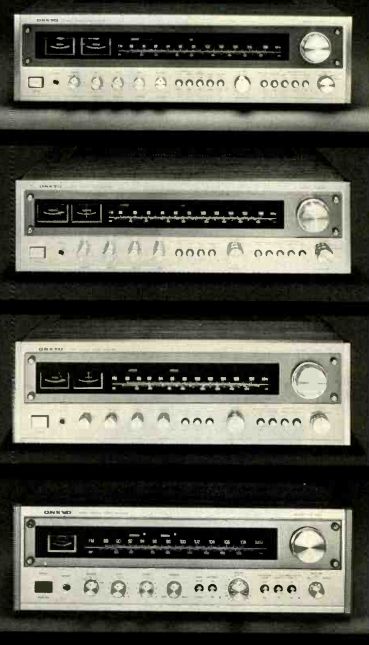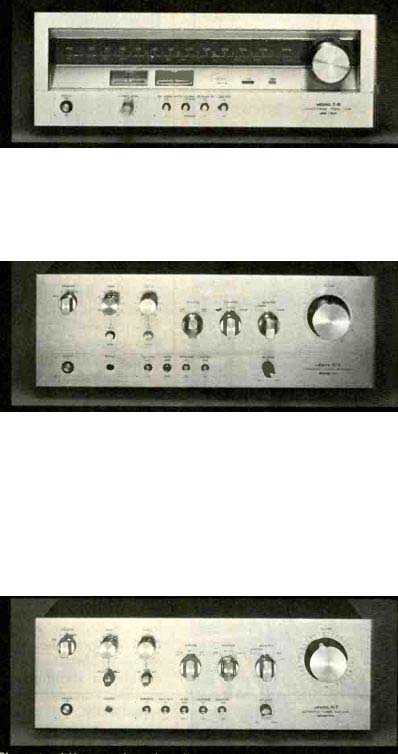Onkyo--A step ahead of State-of-the-Art.
State-of-the-Art is for everyone else. Onkyo design and construction is for tomorrow. Today.

We don't just claim innovation, quality and value. 1.Aie prove it when independent test laboratories publish their unbiased reports in your favorite audio magazines.
Of our TX-4500, one test report said, ':..one of the finest receivers available today at any price.' Of our TX-2500, another said, ':..sounds a good idea better than the data suggest and better than one has a right to expect at S300:' If the data don't suggest the total quality, it may be we're too cautious in our claims. But, we have other equipment too new to have been reported on as yet. All are built to the same exacting standards, featuring exclusive Onkyo advances. We'll try to be a bit less modest as we tell about:
Quartz-Locked Tuning--This is the tuning system of which the most famous testing lab said, ...'a new system that completely eliminates tuning errors in FM reception.' This is done by using a quartz crystal oscillator which takes advantage of the unique capability of precisely ground quartz to maintain a fixed frequency.
The Quartz-Locked circuitry compares the tuner's IF frequency with the frequency generated in the Quartz -Locked oscillator, continually compensating for frequency differences that would cause distortion or poor reception, and additionally compensating the FM tuning meter at the same time.
Servo-Locked Tuning--An economy version of the Quartz-Locked system with similar characteristics in a different configuration. While essentially an automatic frequency control circuit, Servo-Lock is more sophisticated in design and performance and in actual lab tests has held stations for at least 24 hours without perceptible drift.
Quartz-Locked AM/FM Stereo Receiver
TX -8500 -- Power output 110 watts per channel, minimum RMS at 8 ohms, both channels driven from 20 Hz to 213 kHz with no more than 0.1% Total Harmonic Distortion.
Direct coupled differential pure complementary main amplifier with ultra wide frequency response, 2 Hz to 60 kHz 1 dB at main amp. Total Harmonic Distortion less than 0.1% at rated out put; 0.08% at 1 watt output. Rated FM sensitivity 1.7 IN (mono), 4 IN (stereo). 50 dB quieting sensitivity 3 uV (mono), 35 uV (stereo). Image rejection ratio 83 dB; alternate channel selectivity 70 dB; IF rejection ratio 100 dB. S/N ratio 70 dB (mono), 65 dB (stereo).
TX -4500 Power output 55 watts per channel, minimum RMS at 8 ohms, both channels driven from 20 Hz to 20 kHz with no more than 0.1% Total Harmonic Distortion.
Direct coupled differential complementary main amplifier with ultra wide frequency response, 2 Hz to 80 kHz 1 dB at main amp.
Rated FM sensitivity 1.8 uV (stereo). Image rejection and alternate channel selectivity 70 dB. IM distortion 0.3% at rated power; 0.1% at 1 watt output.
Servo-Locked AM/FM Stereo Receivers
TX-2500--Power output 27 watts per channel, minimum RMS at 8 ohms, both channels driven from 40 Hz to 20 kHz with no more than 0.5% Total Harmonic Distortion.
Direct coupled differential main amplifier with frequency response of 2 Hz to 60 kHz 1 dB. Total Harmonic Distortion no more than 0.5% at rated output; 0.2% at 1 watt output. IM distortion 0.5% at rated power; 0.3% at 1 watt output. Usable sensitivity in FM, 2 IN (mono), 5 uV (stereo). Image rejection 45 dB; alternate channel attenuation 60 dB; S N 65 dB (mono), 60 dB t stereo). IF rejection 80 dB.
TX -1500 Power output 15 watts per channel, minimum RMS at 8 ohms, both channels driven from 20 Hz to 20 kHz with no more than 0.5% Total Harmonic Distortion.
Direct coupled differential amplifier with overall frequency response 20 Hz to 20 kHz 1 dB. Total Harmonic Distortion no more than 0.5% at rated power; no more than 0.3% at 1 watt output.
Usable FM sensitivity 2.3 IN (mono), 5 uV (stereo). 50 dB quieting sensitivity 4.5 0/ (mono), 50 IN (stereo). S/ N ratio 65 dB (mono), 60 dB (stereo). IF rejection 80 dB. Alternate channel attenuation 60 dB.
All of Onkyo’s receivers feature multiple speaker outputs as well as multiple tape inputs and outputs including tape to tape dubbing. All are built to specification which often exceed their price ranges with special features, including Phase Locked Loop Multiplex.
Quartz-Locked AM/FM Stereo Tuner
For those who are satisfied with their present amplifier out want the distinct benefits of Quartz -Locked tuning. Onkyo offers the T-9, the only component tuner in the world that has Quartz-Lock.
In addition to the precision tuning capabilities of the T-9, it features o dual gate MOEFET 4 gang -variable capacitor font end with usable sensitivity 1.7 IN, 50 dB quieting sensitivity of ',-: 1iV, 83 dB Image rejection and 73 dB S/N in stereo.
The T-9 uses Phrase Locked Loop Multiplex for low distortion, high separation stereo reception. At 1 kHz, stereo separation is 40 dB; at '00-10,000 HL separation is 35 dB Assuring continuous, drift -free tuning, the FM oscillator circuitry * is hermetically sealed to prevent environmental influence on the components.
Other specifications include an IF rejection ratio of 100 dB and AM suppression ratio of 50 dB. In addition to Quartz-Locked tuning aid exceptional performance characteristics, the Onkyo T-9 provides a special feature for tape recording directly f the ture-.
Known as the Tape Recording Level Check Switch, activation injects a 440 Hz tone k se- recording level through the tape deck. Modulation of the incoming FM signal is red iced to 50%, preventing overloading and distortion. 04../es T-9 provides some of the cleanest tape recording possible.

Solid-State Integrated Amplifiers
What does it all mean?
-------------
(High Fidelity, Apr. 1977)
Also see: